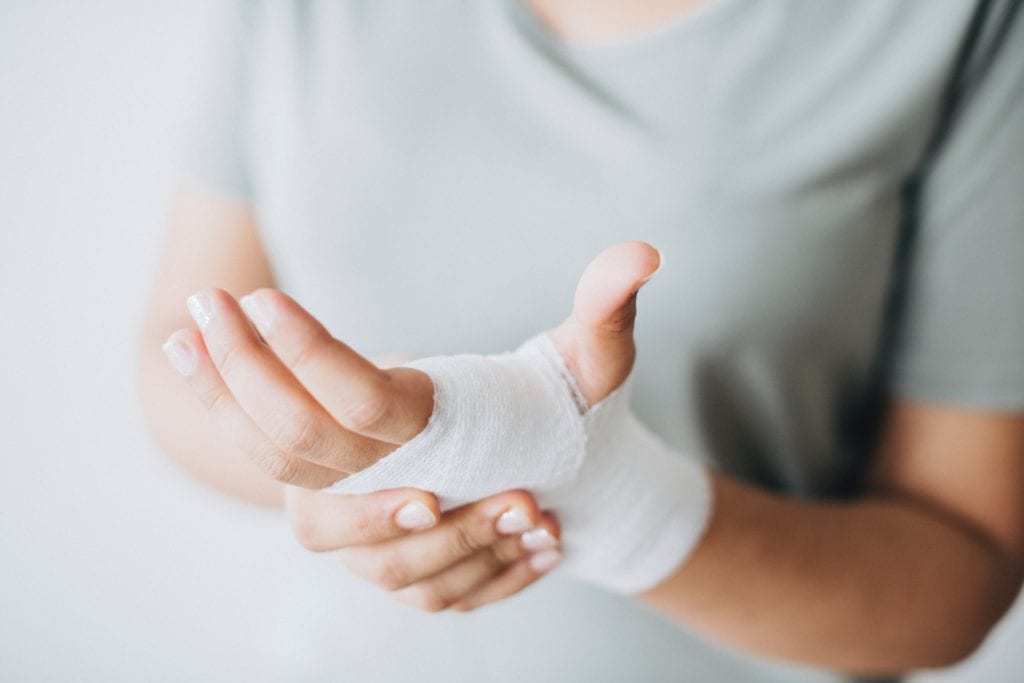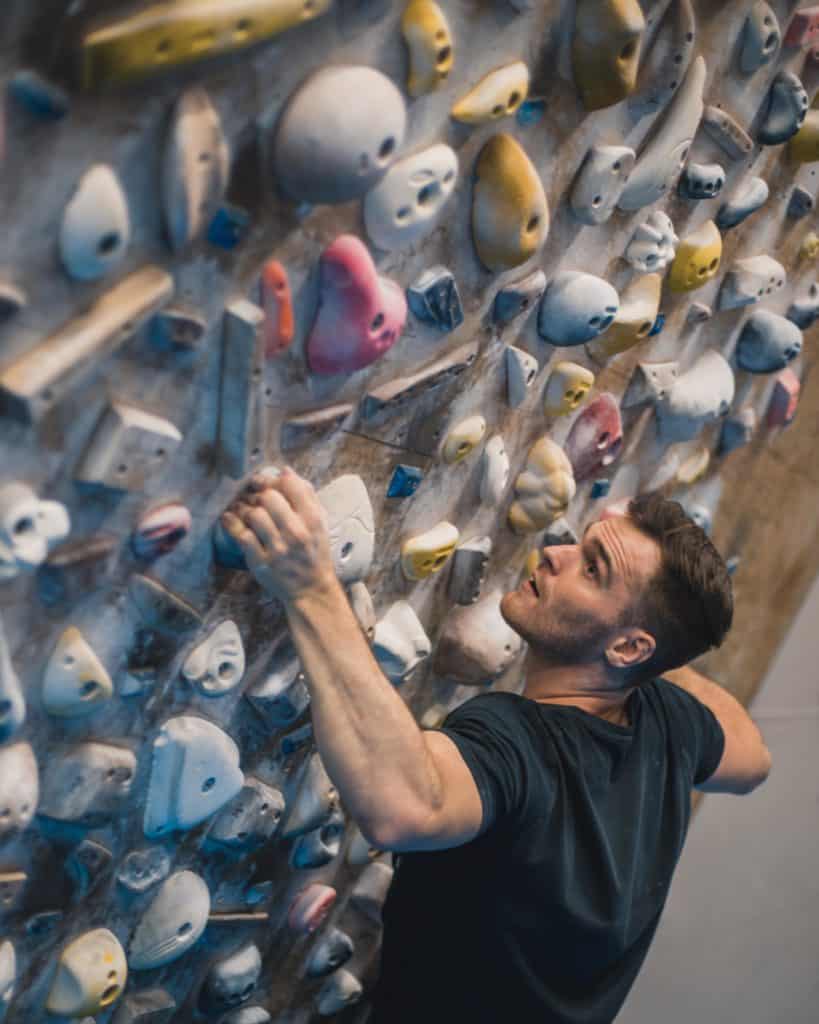
Around 3 months into my climbing adventure I started to increase the amount of days I trained, and in turn managed to injure my back. This was, in my opinion, due to rushing. I wanted to improve faster by increasing the amount of time on the wall but my body wasn’t ready for it. After 2 or 3 weeks I was back training, but again I think I pushed myself a bit too far and slightly injured my back again. It was just over 2 weeks later that I felt I could train. This time though, I was going to take it easy, take regular breaks and listen to my body. After my session I wasn’t injured and my back felt ok. Over the course of the next few weeks I realised there were a few things I could do and a few things I needed to avoid to help my back injury.
So, what should you do if you’re returning to climbing after an injury? If you’ve been injured for a while and you’re returning to climbing then you shouldn’t push yourself. Remember to warm up and stretch all your muscles. You should climb as slowly as possible, primarily using technique, with no dynamic transitions or jerky movements. Take your time between each climb and keep yourself warm throughout the session. Don’t forget to drink water – this is very important when it comes to keeping your body supple and strong while training. Climb lower grades if your usual grade feels like it’s affecting your injury too much. Don’t let your ego affect you – if your injury reappears because you can’t handle climbing a lower grade due to your ego then does that help you in any way? Instead you should take advantage of climbing a grade or two below as technically as you can to help your overall improvement.
For all the do’s and don’ts when returning to climbing after an injury, then keep reading.
Page Jumps
- Do’s
- Don’ts
- Plan Your Session to Avoid Re-Injury
- Change Your Goals to Coincide With the Degree of Your Injury
- Flexibility Is Important
- Be Positive That You’re Back On the Climbing Wall
- Preparing for Your Return to Climbing
- Related Questions
Do’s
Do Stretch Your Muscles and Warm Up/Warm Down
Warming up your muscles before you climb or take part in any physical activity that requires a lot of exertion is critical to avoid getting new injuries and reinjuring old ones. When your body’s warm it’s more supple and ready to exercise. Warming up gradually increases blood circulation, body temperature and heart rate. Stretching your muscles will prepare them for physical activity. Warming up and stretching your muscles is widely known to prevent injuries and should last around 10-20 minutes before proper exercise is started. A warm down of the same caliber is also crucial at the end of the session to avoid muscle and joint stiffness.
Do Climb As Slowly As You Can
When you’re coming back from an injury, one of the worst things you can do is barrel through your climbing session at warp speed. Take your time with each climb and leave at least a minute rest period between each time you get on the wall. By climbing slower you’re allowing yourself to listen to how each part of your body feels with every movement on the climbing wall. You’ll understand if you should or shouldn’t attempt a transition or move because it may affect your old injury.
Do Keep Yourself Warm throughout Your Session
Warming up and stretching is done to keep your body supple and increase blood flow to your muscles to prevent new injuries and old ones from returning. If you let your body rest for too long it’ll become cold which means there’s more chance of injury. Now, that doesn’t mean you have to always be on the climbing wall – all you have to do is keep stretching and moving to keep up the blood circulation and your body temperature.
Do Climb Lower Grades if Your Injury Is Affected by Your Usual Grade
If you aren’t ready to climb your usual grade because your injury is affecting you too much then climbing lower grades isn’t a bad thing at all. It lets you focus on your rock climbing technique properly while staying away from movements that are going to reinjure you. You’ll find that a lot of advanced climbers like to climb lower grades to work on their weaknesses – it’s a great way to improve your technical ability.

Don’ts
Don’t Push Yourself
You may feel great when you get on the wall, like you’re ready to complete numerous climbs on your level, but you could be wrong. You may even find you can climb for 2 or 3 hours, push yourself and your muscles to its limits, only to find that the next day you’ve reinjured the injury that made you rest in the first place. Don’t push yourself – take it steady the first few times of coming back to climbing and let your body get its rhythm back.
Don’t Use Dynamic Movements (Dynos) or Jerky Movements
No matter where your injury is, you can’t be surprised that not using dynamic and jerky movements is on the list of the Don’ts section. You can reinjure yourself from dynos by pulling your muscles or even just by falling on your old injury. It’s probably best to just not try these sorts of movements until you’re ready to climb without fear of re-injury.
Don’t Forget to Drink Water
Keeping yourself hydrated is one of the best ways to keep your muscles strong and supple throughout your session. It’s underrated how much drinking water can actually prevent injuries from happening or reoccurring. It’s so easy to just have a drink every 5 or 10 minutes while you climb so you really have no excuse.
Don’t Let Your Ego Affect You
Just because you think you can do it, or you want to do it, doesn’t mean you should. Your ego may be your downfall when it comes to your old injury. There have been many occasions where I was on the end of an injury and thought to myself that I could do something without it being a problem because of my ego, only to realise I’ve just kept myself out of action for another few weeks. Don’t make the same mistake!
Plan Your Session to Avoid Re-Injury
If you know certain types of climbs are going to affect your old injury, then you may want to avoid those climbs and continue only on the routes that you’re comfortable with. If you know the setup of the climbs you could also plan your session beforehand, even adding in lower grades if you think you need to. Plan your warm up beforehand so you know that your old injury is going to be fully ready for the session ahead, plan the climbs you’re going to attempt (if you can), and plan your warm down at the end of the session to avoid as much soreness, and joint and muscle stiffness the next day.
Change Your Goals to Coincide With the Degree of Your Injury
Before you were injured you may have had goals of a certain degree that you thought could achieve, but now you’ve come back from injury it may take you a lot longer before you can complete the goal you previously set. That’s not to say it can’t be achieved in the long run but you might have to introduce smaller goals before you hit the next one. This, of course, depends on how big the goal was before you injured yourself and how serious the actual injury was.
For example: Before your injury you were a V3 climber with a goal to achieve V5 within 12 months. That’s quite achievable usually for the average human with a bit of hard work behind him; but after your injury you’ve lost a little strength in that area and it’s a little harder than you thought. Instead you can lower the achievement to V4 within 8 months. It’s still an improvement but gives you a little bit more time to aim for something lower. If you were going for V5 in 12 months, it should hopefully take you less than 8 months to achieve V4 when healthy. Now you’re on the end of your injury this could be a more realistic goal. You need to feel a sense of achievement quickly to keep your morale up after you were injured.
Flexibility Is Important
It’s starting to become more common knowledge that keeping yourself flexible outside of your training is great to avoid injuries overall. You can stretch at home quite easily these days by watching a yoga video on YouTube and taking instructions. Even stretching at home while watching the TV can help with flexibility, but I’d highly recommend researching into what stretches are safe and which aren’t before you begin.
Be Positive That You’re Back on the Climbing Wall
Your mental attitude towards climbing when you’re returning from an injury has a massive effect on how you perform. If you’re positive that you can climb well even though you’ve just been injured you’ll probably have a fun time and your mind will be open enough to work around your weakness. What good does it do to be cynical while you’re climbing? Even if your injury starts to flare up, realise you’ve learnt that it’s too early to return and focus on your rehab until next time.
Preparing for Your Return to Climbing
Before you start climbing again after an injury you might want to think about strengthening the muscles and joints around that area, get a bit more flexible, or actually work out if your injury is ready to be trained on.
Strengthening a particular body part or area after an injury should be done with a light load or weight, slowly increasing as your muscle’s power rises. Yoga can also help you keep all your muscles and joints flexible while strengthening before you return to rock climbing.
If you’re injured and it looks like you might be out of action for a while but you want to return to climbing, try to keep your strength up in particular areas such as your fingers and forearms (if you’re not injured there) so that you don’t return with too much of a disadvantage. Using the fingerboard or even doing pull ups for your back muscles is going to help your climbing when you return.
Related Questions
Should you workout when injured? If you’re going to workout or train when injured then you should avoid using that muscle or area at all costs or just avoid training in general. You’re only going to make the injury worse if you push it once it’s already there.
Should you rest a pulled muscle? It is advised to rest a pull muscle and give it the usual rehabilitation treatment of RICE: Rest, Ice, Compression, and Elevation. Do this until your muscle is ready to be trained on again, and then reintroduce light workouts and training.
